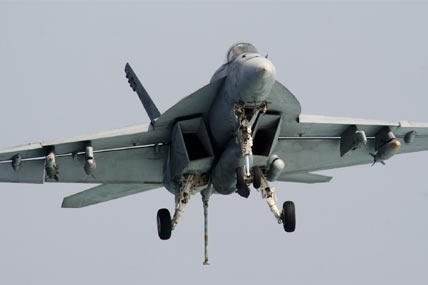SAINT LOUIS -- Engineers here with aerospace titan Boeing are considering a number of improvements to the company's F/A-18 Super Hornet fighter to keep it competitive on the international market for at least another 10 years, officials said. One idea is to give a Super Hornet some aircraft of its own.
Among the potential upgrades to the E and F-model jets is the ability to launch and control unmanned aerial vehicles. Boeing engineers are working on developing avionics that would allow Super Hornets to carry a drone similar to the latest version of Insitu's ScanEagle UAV, dubbed the "compressed-carriage Scan Eagle," in a canister on the jet, said Mike Gibbons, the company's vice president of operations for its F/A-18s and E/A-18G Growlers.
A Super Hornet's pilot could someday release the drone from a safe distance away from a ground target, tell the ScanEagle where to go and access real-time targeting data from the drone, Gibbons said.
Boeing wants to add these and other novel capabilities to ensure its aircraft appeal to customers increasingly concerned about the survivability of older fighter designs in fights against enemies equipped with 21st century fighter jets and advanced air defenses, known as anti-access and area denial weapons.
Other potential upgrades to the Super Hornet could include the installation of a stealthy weapons pod; conformal fuel tanks along the upper fuselage that give the jet more than 3,500 gallons of additional fuel; enhanced General Electric engines that would provide increased fuel efficiency and up to 20 percent more thrust; and a bevy of avionics and sensor upgrades designed to improve the plane's ability to collect and share data as well as jam enemy sensors. All the information gathered by these sensors would be displayed in the cockpit on a giant, color touch screen resembling a large iPad.
While Boeing has no official contracts to install these features on any of its Super Hornets, it is conducting research and development work to ensure that it can do so, should a customer request them.
"As international customers buy Super Hornets, they can tailor it to their needs" as they evolve by taking advantage of the new features that Boeing is researching, said Chris Chadwick, head of Boeing's military aircraft division, during a June 7 meeting with reporters.
Boeing hopes this upgrade, "Flight Plan" will keep the jet a "high-performance, low-cost" option for countries looking to replace their existing fleets of F/A-18 Hornets -- or new customers in the Middle East and Asia.
Chadwick said Boeing continues to talk with current buyers of Lockheed Martin's F-35 Lightning II, reminding them of the capabilities and low cost of the Super Hornet in light of the F-35's delays and cost increases, he said.
In the near-term, the Chicago-based firm remains focused on winning the long-running F-X2 fighter contest in Brazil, pitting the Super Hornet against the Swedish Saab Gripen and the French Dassault Rafale to supply the Brazilian air force with around 35 fighters. That contest is supposed to wrap up this month.
The Rafale was falsely reported to have won that contest several times in the past during the administration of former Brazilian president of Lula da Silva. However, current Brazilian leader Dilma Rousseff appears to want to put her own stamp of approval on the deal. Brasilia has been reaching out extensively to the United States, sending "lots of positive vibes" in light of Washington giving Boeing permission provide Brazilian industry with access to Super Hornet technology and Boeing's agreement to purchase supplies from Brazilian firms under a so-called "offset agreement."
A victory in Brazil's relatively small F-X2 contest would allow Boeing to lay the foundation of a long-term relationship with Latin America's largest economic power and a rising star on the international stage -- opening the door for future business as the nation grows, Chadwick said.




























